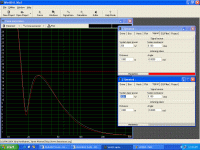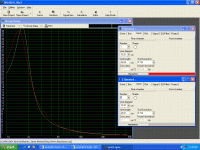Yeah, it's true that the curve looks nice. I prefer mine because I think it's closer to room gain so flat in room response but your idea with the resistor is good too. If you look at the SPL curve, it's similar anyway.
I guess your idea or mine will be good. Your idea need a little bit more excursion than mine.
I guess your idea or mine will be good. Your idea need a little bit more excursion than mine.
The driver can't take as much power, and the output is hindered a bit at the low end, but it has a lower group delay. Interesting option. Room gain might pick up a bit of the bottom end, but I'm not so sure -- his room is pretty big. I think the mid Q option might rob a few dB, which has probably not been calculated into the equation, but for the price of a 1.5ohm resistor how can you go wrong with a bit of experimentation?
The 10% tip is nice, but I think it would be better if someone could do some experimentation to prove that.
Because I'm quite sure that 34 m/s is worse if your subwoofer is playing at 100 dB than if your subwoofer was playing at 120 dB...
Also, we don't always play the subwoofer at full output so I guess we are mostly always under 34 m/s.
Also, by using flared ports, you correct much of the noise issue.
Because I'm quite sure that 34 m/s is worse if your subwoofer is playing at 100 dB than if your subwoofer was playing at 120 dB...
Also, we don't always play the subwoofer at full output so I guess we are mostly always under 34 m/s.
Also, by using flared ports, you correct much of the noise issue.
I'm a bit new to WinISD, but it looks like it doesn't have a room gain calculator, and I haven't found a nice one on the net. Adire LspCAD has one as I recall, but you can only use the loaded drivers. Reviewing JiggaD's room substantial room size (30x15), I guess the extra dB of the low Q design will help out, at least with home theater. Could set up a variable Q switch, but I think overall the low Q will probably work out for the best. I was trying to squeeze out a bit more SQ (original design criteria) with the lower group delay, but the difference may prove to be negligible.
I'm currently using the Adire Audio room gain curve, but it's for a 4m x 5.5m x 2.3m room (13' x 18' x 7.5' room).
You can see it at the page #5 of this document :
http://www.acoustic-visions.com/~acoustic/products/subwoofer_drivers/adire_shiva/ventedshiva.pdf
In WinISD, I guess you could approximate this room gain curve with a Parametric Equalizer, with fc at 10 Hz, Gain at 6 dB and Q at 0.4
You need to remove this equalizer before checking excursion because WinISD will take this filter into account when checking for excursion.
You can see it at the page #5 of this document :
http://www.acoustic-visions.com/~acoustic/products/subwoofer_drivers/adire_shiva/ventedshiva.pdf
In WinISD, I guess you could approximate this room gain curve with a Parametric Equalizer, with fc at 10 Hz, Gain at 6 dB and Q at 0.4
You need to remove this equalizer before checking excursion because WinISD will take this filter into account when checking for excursion.
No. what i meant by HIgh Level Inputs was, running the 8 wires for the front/surround channels to the amp, then running them to the speakers (the red and black binding posts on the plate amp).
So what would you guys recommend after all of the analysis? which box, which driver, what config.?
So what would you guys recommend after all of the analysis? which box, which driver, what config.?
You don't have a line-out or a subwoofer-out on your speaker amp?
If you don't have one, I would run only front speakers to high-level imputs, front left and front right to their respective high-level imputs. Don't run all the wires there, you'll short-circuit everything.
After analysis, I recommend Atlas 12 in the 142.5 liters box with one 4" diameter full-length flared Precision Port and a 350W Rythmik Audio amplifier.
If you don't have one, I would run only front speakers to high-level imputs, front left and front right to their respective high-level imputs. Don't run all the wires there, you'll short-circuit everything.
After analysis, I recommend Atlas 12 in the 142.5 liters box with one 4" diameter full-length flared Precision Port and a 350W Rythmik Audio amplifier.
Yes. To achieve the low Q design, run a link through the gold terminals. If you leave this link open you will get a high Q design, which will probably give you strange response.
The Rythmik 350 will push your budget closer to $350 +. The Rythmik 250 will also work, but the 350 will obviously give you more output. If you go with the 350, I would not try messing around with the mid Q design in the future, as it is liable to cook your driver at high volumes.
To simon5: Is the rolloff on the standard Rythmik 250/350 12dB on both the rumble and the lowpass filter?
The Rythmik 350 will push your budget closer to $350 +. The Rythmik 250 will also work, but the 350 will obviously give you more output. If you go with the 350, I would not try messing around with the mid Q design in the future, as it is liable to cook your driver at high volumes.
To simon5: Is the rolloff on the standard Rythmik 250/350 12dB on both the rumble and the lowpass filter?
Yes, there's 8 binding posts, 4 for imput and 4 for output.
Imput:
1 for + front left
1 for - front left
1 for + front right
1 for - front right
Output:
1 for + front left
1 for - front left
1 for + front right
1 for - front right
350W will not be too much for the driver, but if you think the 350W version is too pricey or too loud, it's ok. It will be loud enough anyway, that's for sure.
Use a speaker wire to connect the two gold terminals together like Raoul said, to achieve the desired frequency response.
To Raoul: The rumble filter is always 12 dB. On normal edition, the lowpass is also 12 dB. If you buy special editions, you can have a 24 dB lowpass if you specify that.
Imput:
1 for + front left
1 for - front left
1 for + front right
1 for - front right
Output:
1 for + front left
1 for - front left
1 for + front right
1 for - front right
350W will not be too much for the driver, but if you think the 350W version is too pricey or too loud, it's ok. It will be loud enough anyway, that's for sure.
Use a speaker wire to connect the two gold terminals together like Raoul said, to achieve the desired frequency response.
To Raoul: The rumble filter is always 12 dB. On normal edition, the lowpass is also 12 dB. If you buy special editions, you can have a 24 dB lowpass if you specify that.
- Status
- This old topic is closed. If you want to reopen this topic, contact a moderator using the "Report Post" button.
- Home
- Loudspeakers
- Subwoofers
- PLease help designing my first sub.

